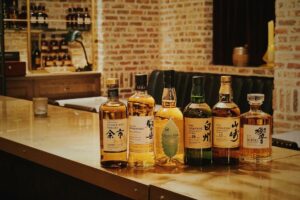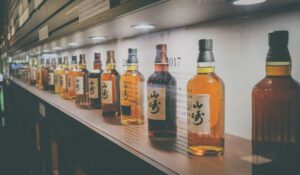
What makes Japanese whiskey so special?
When you know the secret, you will feel, “I know, sure.
By learning about the history and characteristics of Japanese whiskey, you will be able to taste it more deeply.
This article details the birth, development, and worldwide reputation of Japanese whiskey.
As a whisky expert, I will guide you through the profound world of whisky.
You’ll be amazed at how easy it is to get the most out of it.
Birth of Japanese Whiskey

The history of Japanese whiskey began in the late 19th century.
At that time, Japan was undergoing the Meiji Restoration and was actively trying to adopt Western culture and technology.
Whiskey was also a focus of attention as part of this effort, but early trials and errors resulted in products that differed greatly from Western whiskey.
Japanese whiskey makers have taken on many challenges in their quest to stabilize quality and improve flavor.
Early trial and error
Whiskey making began in Japan from the end of the 19th century to the beginning of the 20th century, but the road was not a smooth one.
Initially, demand for whiskey in Japan was limited and production techniques were not yet established.
Early Japanese whiskey was made by mixing it with imported Western liquors or by flavoring the alcohol.
As a result, the quality and flavor varied and was not yet comparable to Western whiskey.
Relationship with Scotland
A major influence on the quality of Japanese whiskey was the relationship with Scotland.
Many Japanese have studied in Scotland to learn the skills and knowledge of whisky production.
One of the most famous of these is Masataka Taketsuru.
Taketsuru learned authentic whiskey making in Scotland and brought his skills back to Japan.
His experience and knowledge were of great help when he later founded Nikka Whiskey.
Establishment of Yamazaki Distillery
Full-scale production of Japanese whiskey began with the Yamazaki Distillery, established by Suntory in 1923.
The Yamazaki distillery is located in Yamazaki, near Kyoto, where the quality of the water and moderate climate were considered ideal for whiskey making.
Yamazaki Distillery played an important role in the subsequent development of Japanese whiskey as the first authentic whiskey distillery in Japan.
It was here that the first domestic whiskey was produced under the guidance of the first master blender, laying the foundation for the Japanese whiskey industry.
Role of the First Master Blender
Masataka Taketsuru, the first master blender, played a very important role.
He used his experience in Scotland to lay the foundation for Japan’s own whisky making.
Taketsuru’s passion and skill were passed on to both Suntory and Nikka brands, and contributed greatly to improving the quality of Japanese whiskey.
His efforts were not limited to the mere introduction of technology, but were also a pursuit of whisky making adapted to the climate and culture of Japan.
Taketsuru’s influence is an important factor leading to the high reputation of Japanese whiskey today.
Development of Japanese Whiskey

Through early trials and errors, Japanese whiskey gradually established its quality and technology.
Numerous challenges and improvements were made before and after the war, leading up to the current high reputation.
Here we will take a closer look at the history of how Japanese whiskey has developed.
Prewar Challenges and Successes
The full development of Japanese whiskey progressed during the 1920s and 1930s.
In 1929, Suntory launched Japan’s first real whiskey, Shirofuda.
This was a tried-and-true product, and its success had a major impact on the domestic whiskey market.
Whiskey was still a rarity in Japan at the time, but the success of “Shirofuda” rapidly increased awareness and demand for whiskey.
During this period, Japanese whiskey makers worked to improve quality and introduced various technologies.
Based on the techniques learned in Scotland, a manufacturing method suited to the Japanese climate and climate was sought.
Particular attention is paid to the quality of the water, and the use of pure spring water produces whiskey with a unique flavor.
These efforts bore fruit in the 1930s, when a series of high-quality whiskeys were produced in Japan.
A fresh start after the war
During World War II, whiskey production had to be temporarily suspended.
However, whisky production resumed again during the postwar reconstruction period, and further technical innovations were made.
In the 1950s, Suntory launched “Akafuda,” which became a huge hit.
As postwar Japan experienced rapid economic growth and people’s standard of living improved, demand for whiskey also grew.
In the postwar re-launch, whisky makers continued to draw on their prewar experience to further improve quality.
New production equipment and techniques are introduced, and innovative methods are tried in the fermentation and aging process.
This has allowed Japanese whiskey to be appreciated both domestically and internationally as a product with its own unique flavor and aroma.
Introduction of new technology
The introduction of new technology played a major role in the postwar re-launch.
Improvements in distillation and blending techniques are producing whiskies with greater complexity and depth.
Innovative techniques were also introduced into the fermentation and maturation process, which allowed Japanese whiskey to stand out for its unique character.
Of particular note is the use of wooden barrels.
The use of certain types of oak barrels gives Japanese whiskey a unique flavor not found in other whiskeys.
This gave birth to a whiskey with a flavor and aroma unique to Japan.
New technologies were also introduced to optimize the ripening environment, including temperature and humidity control.
This ensures that the quality of the whisky is stable and always of a high standard.
Distillery Expansion
During the 1950s and 1960s, new distilleries were established throughout Japan.
In addition to Suntory and Nikka, other companies entered the whiskey production market, and the domestic market became increasingly active.
Each distillery made whiskies that took advantage of the characteristics of their respective regions, producing a succession of products with diverse flavors and personalities.
For example, Masataka Taketsuru, the founder of Nikka Whiskey, established a distillery in Yoichi, Hokkaido, and adopted traditional Scottish methods.
The Yoichi distillery takes advantage of the cold climate and abundant natural resources to produce a smoky, peat-based whiskey.
In addition to the Yamazaki Distillery, Suntory also established the Hakushu Distillery, which offers whisky made from the pure water of the Southern Alps.
This expansion of distilleries has enriched the variety of Japanese whiskey and further enhanced its appeal.
As each distillery produced whisky with its own unique flavor and characteristics, the popularity of Japanese whisky increased as consumers were given more choices.
Birth of major Japanese whiskey brands

An essential part of the history of Japanese whiskey is the birth and development of major brands.
Suntory and Nikka are two of the leading players in this field, and the competition and cooperation between them has supported the growth of the Japanese whiskey industry.
Other brands have also emerged in recent years, further increasing the diversity and quality of Japanese whiskey.
Through these developments, Japanese whiskey has come to be highly regarded both domestically and internationally, and has established its position.
Establishment and Development of Suntory
Suntory is best known for establishing Japan’s first real whiskey distillery, the Yamazaki Distillery.
The Yamazaki Distillery, established in 1923, is located in Yamazaki near Kyoto, Japan, and took advantage of the region’s high-quality water and climate to produce whiskey.
In 1929, Suntory launched a whisky named “Shirofuda,” which greatly contributed to the popularization of whisky in Japan.
Since then, Suntory has released many popular products one after another, including “Akafuda,” which has received high acclaim both in Japan and abroad.
Suntory’s success is the result of its relentless efforts in technological innovation and quality improvement, which have made it a leader in the Japanese whiskey industry.
Furthermore, in addition to the Yamazaki Distillery, Suntory has established the Hakushu Distillery to produce whisky using the pure water of the Southern Alps to enhance its product lineup.
Masataka Taketsuru, founder of Nikka Whiskey
Masataka Taketsuru, the founder of Nikka Whisky, studied whisky making in Scotland and brought his skills and passion back to Japan.
In 1934, Taketsuru established a distillery in Yoichi, Hokkaido, and began making whiskey using traditional Scottish methods.
The Yoichi distillery takes advantage of the cold climate and abundant natural resources to produce a smoky, peat-based whiskey.
Taketsuru’s belief was to “make real whiskey,” and this passion was reflected in Nikka Whiskey’s products.
Nikka whiskey has a unique flavor and aroma and is highly regarded both in Japan and abroad.
The “Taketsuru” brand, in particular, has won numerous international awards and played a role in spreading the name of Japanese whiskey throughout the world.
Competition between Suntory and Nikka
The competition between Suntory and Nikka contributed greatly to the development of the Japanese whiskey industry.
Both take different approaches to whisky production and strive to improve the quality of their whiskies.
Suntory produces whisky with the characteristics of its Yamazaki and Hakushu distilleries, with a fruity, well-balanced flavor.
Nikka, on the other hand, emphasizes a process rooted in Scottish tradition, offering whiskies with a strong, smoky flavor.
This competition has brought diversity to the Japanese whiskey market and increased choice for consumers.
Friendly competition between the two companies has also led to technological innovation, which in turn has boosted the quality of Japanese whiskey as a whole.
Today, Suntory and Nikka products are highly acclaimed around the world and are recognized as the best representatives of Japanese whiskey.
Rise of Other Brands
In addition to Suntory and Nikka, other brands have recently entered the Japanese whiskey market, further expanding its diversity.
For example, the Karuizawa distillery takes advantage of its unique climatic conditions to produce whiskey with a unique flavor.
The Chichibu distillery, operated by Venture Whisky, also produces high quality whiskey and is attracting attention both in Japan and abroad.
These emerging brands are further enhancing the appeal of Japanese whiskey by taking advantage of their regional characteristics to produce unique whiskeys.
In particular, the Chichibu Distillery, a venture whisky distillery, has been releasing innovative products one after another as young distillers continue to take on new challenges.
This has given Japanese whiskey even greater diversity and depth.
Emergence of regional distilleries
New distilleries are being established throughout Japan, producing whiskey that takes advantage of the characteristics of the region.
For example, the Miyagikyo distillery takes advantage of the rich natural environment of Miyagi Prefecture to make light, fruity whiskey.
And the Saburomaru distillery, operated by Wakatsuru Shuzo in Toyama Prefecture, provides whiskey with a unique flavor by aging it in barrels made from local wood.
The emergence of regional distilleries has further enriched the variety of Japanese whiskey, offering consumers new tastes and experiences.
Whiskey that reflects the characteristics of each region, with flavors and aromas unique to that region, is popular both in Japan and abroad.
In this way, the appeal of Japanese whiskey has been further enhanced and its international reputation has grown ever stronger.
Japanese Whiskey Goes Global

After its success in Japan, Japanese whiskey gradually entered the global market.
The unique flavor and quality of the product was recognized, and the company established itself by winning many international awards.
Here we take a closer look at the history of Japanese whiskey’s global expansion and its impact.
International Recognition and Awards
The global reputation of Japanese whiskey began to grow in the early 2000s when it won awards in numerous international whiskey competitions.
In particular, in 2003, Nikka’s Yoichi 10-nenri won the “Best of the Best” award from Whisky Magazine, followed by Suntory’s Yamazaki 18-nenri and Hibiki 21-nenri, which won a series of world-class awards.
These awards brought international recognition of the quality of Japanese whiskey and rapidly increased its demand.
International Market Strategy
As Japanese whiskey gained international recognition, Japanese whiskey makers aggressively sought to expand into overseas markets.
Suntory and Nikka will develop marketing strategies to promote their respective brands, particularly in Europe and the United States.
For example, to strengthen its presence in the U.S. market, Suntory partnered with a local distributor to develop an advertising campaign.
Nikka is also strengthening its sales in the European market, particularly in France and the UK, where it is gaining recognition.
Growing global demand
Once the quality of Japanese whiskey was recognized internationally, demand for it grew rapidly.
Especially in the United States, Europe, and Asian countries, the popularity of Japanese whiskey has skyrocketed, with many consumers demanding its unique flavor and quality.
In response to this growing demand, Japanese whiskey producers strengthened their production systems and increased export volumes.
Partnerships with overseas distilleries
With the growing popularity of Japanese whiskey, Japanese whiskey makers have become more active in partnering with foreign distilleries.
Suntory has established an international network, including ownership of the famous Scottish distillery Bowmore.
This has made it possible to share know-how on whiskey production and further improve the quality of the product.
Similarly, Nikka is building cooperative relationships with overseas distilleries to promote technological exchange and joint development.
This has further refined the manufacturing technology of Japanese whiskey and further strengthened its competitiveness in the global market.
Furthermore, these alliances strengthen the international brand image of Japanese whiskey and enhance its credibility for consumers.
summary

Japanese whiskey has developed a long history and numerous challenges to become internationally acclaimed.
Beginning with early trial and error at the end of the 19th century, the introduction of Scottish technology and important events such as Masataka Taketsuru and the establishment of Suntory’s Yamazaki distillery have contributed greatly to the improvement of the quality of Japanese whiskey.
Technological innovations and the establishment of new distilleries before and after World War II established a unique flavor and high quality.
Competition and cooperation between the major brands, Suntory and Nikka, drive the Japanese whiskey industry and provide a diverse product lineup.
In recent years, the appearance of regional distilleries and the rise of emerging brands have further enriched the variety of Japanese whiskey.
Thanks to its international reputation and numerous awards, Japanese whiskey is in high demand in the global market and has solidified its position through aggressive overseas expansion and partnerships.
The future of Japanese whiskey is bright and its appeal will spread to more and more people.
Let us continue to enjoy the unique flavors and qualities of Japanese whiskey and explore its profound world.

30s male writer. He has worked in a hotel for 16 years and is involved in the travel industry. Through his work at travel agencies and hotels, he developed an interest in travel and often goes on trips. His favorite cities are Sendai and Hakata. He conveys the knowledge he has gained through his travels and the charms of Japan with care.


